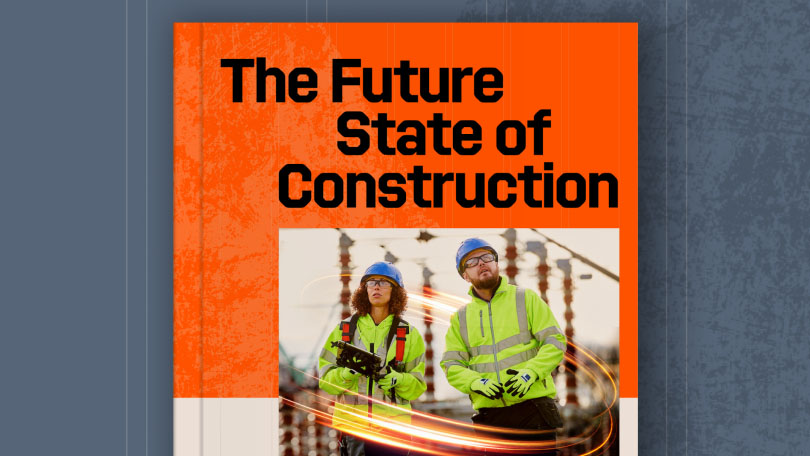— 8 min read
How Cost Value Reconciliation Drives Project Success


Last Updated Aug 28, 2025

Nicholas Dunbar
Content Manager
62 articles
Nick Dunbar oversees the creation and management of UK and Ireland educational content at Procore. Previously, he worked as a sustainability writer at the Building Research Establishment and served as a sustainability consultant within the built environment sector. Nick holds degrees in industrial sustainability and environmental sciences and lives in Camden, London.

Zoe Mullan
27 articles
Zoe Mullan is an experienced content writer and editor with a background in marketing and communications in the e-learning sector. Zoe holds an MA in English Literature and History from the University of Glasgow and a PGDip in Journalism from the University of Strathclyde and lives in Northern Ireland.
Last Updated Aug 28, 2025

Construction teams face an ongoing challenge: maintaining equilibrium between costs, timelines, and delivered value when margins are tight and projects shift daily. Cost Value Reconciliation (CVR) provides the solution. Though often overlooked outside financial circles, CVR ranks among the most useful tools for staying on budget and in control, offering a clear view of where money flows and what teams truly achieve.
Table of contents
Understanding Cost Value Reconciliation
Cost Value Reconciliation (CVR) is one of the construction industry's most valuable – yet often underutilised – financial tools. The process tracks the relationship between project costs to date and the value of completed work, providing real-time financial performance insights.
CVR answers a crucial question: Are we spending in line with the value we're delivering? By regularly comparing actual costs against earned value, project teams spot early overspend warning signs, improve cost forecasting, and make better-informed decisions before small issues escalate.
Learn about the future of the built environment - Read Procore's Future State of Construction report
Learn how contractors, subcontractors, and project teams can take advantage of new opportunities to boost efficiency and profitability over the next decade. Download the report to get your roadmap to the future state of construction.

Why CVR Matters in Construction
Cost Value Reconciliation is a financial exercise and strategic process that helps construction teams understand their project's overall health. Effective CVR reveals whether a project stays on track and identifies areas needing attention to remain within scope and budget. The core objectives include:
Monitoring Project Profitability
CVR compares actual costs with completed work value, helping teams assess whether projects earn as expected. When value generation consistently lags behind spending, profitability faces risk, prompting early corrective measures.
Identifying Discrepancies
Meanwhile, CVR brings cost deviations into focus by highlighting variances between planned and actual figures. This includes overspending in any area, from labour or materials to scope changes. Consequently, project teams can investigate causes and act before gaps widen.
Improving Cost Management
Additionally, accurate, up-to-date CVRs create a feedback loop for better cost control. This enables teams to adjust forecasts, track contract variations, and manage resources more efficiently.
Supporting Decision-Making
With clear cost versus value data, CVR supports better decisions at every level. From resourcing and subcontractor planning to adjusting timelines or renegotiating terms, it transforms cost data into actionable insight, giving stakeholders confidence to act early.
How CVR Works in Construction
Construction teams typically carry out Cost Value Reconciliation monthly – aligned with valuation dates or stipulated UK payment cycles – following a structured process. Essentially, CVR tracks delivered value versus spending. However, understanding which metrics CVR measures is crucial.
Essential CVR Metrics
CVR tracks the following metrics to assess financial performance and project health:
- Project costs: actual costs incurred across labour, materials, equipment, and subcontractors
- Earned value: the value of work completed to date, based on contract valuations
- Cash flow: money movement in and out of the project
- Resource utilisation: efficiency of labour and material usage
- Project timeline alignment: whether financials align with schedule progress
These metrics form the basis for calculating cost-value variances and informing decisions throughout the project lifecycle. Once teams define metrics, the CVR process follows structured steps:
The CVR Process
Costs vs Value
This step involves gathering actual cost data to date, including labour, materials, subcontractors, plant, and preliminaries. Teams then compare this against completed work value – based on contract milestones, interim payment applications, or earned-value calculations.
Calculating Variances
Next, teams calculate the variance as the difference between spending and earnings. A positive variance indicates profitability; a negative one signals a shortfall. Tracking these variances reveals patterns and highlights concern areas.
Reporting and Analysis
Subsequently, teams compile CVR results into reports or spreadsheets that provide stakeholders with clear financial performance overviews. These inform project reviews, support monthly cost meetings, and feed into wider commercial strategy.
Regular Updates
Finally, effective CVR requires regular updates, usually aligned with the project's reporting cycle. This enables quick reflection of scope changes, unexpected costs, or delays, keeping financial data current and actionable.
CVR in Action: A Practical Example
Here's a simplified CVR example showing cost and value comparison across key categories. In this case, the project currently sits £5,000 ahead of target, though the negative variance on materials requires attention.
| Category | Actual Cost (£) | Value Earned (£) | Variance (£) | |
| Labour | 100,000 | 105,000 | +5,000 | |
| Materials | 80,000 | 75,000 | -5,000 | |
| Subcontractors | 60,000 | 65,000 | +5,000 | |
| Total | 240,000 | 245,000 | +5,000 |
Key CVR Benefits
Cost Value Reconciliation provides the visibility and control needed to protect profit margins in a high-risk industry. It gives contractors and project teams the information they need to make sharper financial decisions. The key benefits include:
Early Problem Identification
By regularly comparing actual spending against earned value, CVR highlights cost overruns or shortfalls early. This gives teams opportunities to act before issues escalate, whether adjusting procurement, reassigning resources, or reviewing subcontractor performance.
Enhanced Cost Control
Routine CVR helps teams monitor spending closely and assess whether it delivers equivalent value. This visibility allows better variation tracking, tighter provisional sum control, and more realistic forecasting.
Improved Decision-Making
With timely and accurate data at hand, project managers and commercial teams make decisions with greater confidence. From managing scope changes to renegotiating contract terms, CVR provides a reliable financial baseline.
Better Profitability
Most importantly, CVR helps protect project margins by identifying inefficiencies, reducing financial surprises, and supporting proactive commercial management. This oversight proves essential for contractors working on tight budgets or fixed-price contracts.
Additionally, accurate cost tracking supports compliance with key duties under frameworks like the Construction (Design and Management) Regulations, which assign accountability to duty holders for managing risk, resources, and responsibilities throughout projects.
Implementing CVR: Components and Process
Putting Cost Value Reconciliation into practice requires coordination. While this varies depending on project size, CVR reporting in the UK often involves quantity surveyors working with commercial teams, project managers, and finance departments.
Essential Components
A well-run CVR process includes these key components:
- Cost data: actual spending figures from procurement records, payroll, subcontractor invoices, and site costs
- Value earned: completed work valuation, often based on progress claims, contract milestones, or percentage-completion assessments
- Programme updates: regular project schedule input to assess whether completed work aligns with timelines and projected outputs
- Variation tracking: records of approved and pending variations, ensuring accurate scope change reflection
- Reporting templates: standardised CVR formats or software-generated reports enabling consistent analysis and data sharing
Standard Implementation Process
Teams should follow these six main steps in a standard CVR process:
Collect Cost Data
Collect actual cost data from all relevant sources and verify accuracy across categories (labour, materials, preliminaries, etc.).
Assess Work Value
Assess completed work value using agreed methods, such as interim valuations or earned value assessments.
Calculate Variance
Work out the variance between cost and value, identifying any over- or under-performance.
Analyse Variances
Analyse key variances to understand causes and identify trends or problem areas.
CVR Report
Generate a CVR report for internal review (often monthly) and use it to inform project meetings and commercial decisions.
Update Regularly
Update regularly to account for progress changes, variations, or new costs.
Overcoming CVR Challenges
While essential for financial control, Cost Value Reconciliation often presents challenges, particularly when managed manually or across disconnected systems.
Common Challenges
The challenges of CVR typically relate to:
Manual Data Entry
Many CVR processes rely on spreadsheets and paper-based tracking. This leads to data entry errors, version control issues, and team miscommunication.
Delayed or Incomplete Data:
Accurate CVR depends on up-to-date inputs. When cost data or progress updates are delayed or come from multiple sources, resulting reports may reflect an outdated view of the project's financial position.
Lack of Standardisation
Without a consistent CVR reporting structure, teams may use different formats, assumptions, or valuation methods. This makes comparing, tracking, or analysing financial performance across projects harder.
Time-Consuming Processes
Compiling cost and value data from various systems – particularly at scale – can be resource-heavy and slow, taking teams away from higher-value work like forecasting or strategy.
Practical Solutions
Several solutions can address CVR process shortcomings:
Digital Collaboration Tools
Replacing spreadsheets with integrated software streamlines the process, reduces duplication, and keeps everyone aligned with real-time data.
Standardised Templates
Using consistent formats across projects provides clarity, simplifies training, and makes cross-project reporting easier.
Regular, Automated Updates
Linking cost management systems to real-time site data helps teams track actual performance without waiting for month-end manual entry.
Technology’s Role in Modern CVR
What was once a time-consuming and error-prone task filled with spreadsheets and guesswork has become smoother and far more accurate. With the right digital tools, CVR becomes faster and can be carried out more frequently, making it useful as a strategic driver of project performance.
Technology Benefits
Modern technology helps with:
Streamlined Data Collection
Construction platforms integrate with scheduling, procurement, and financial systems to automatically collect the latest cost and progress data. This means project managers don't need to chase spreadsheets or rely on manual updates to understand project financial health.
Improved Accuracy
Automation reduces human error risk and provides consistency in cost and value calculations. Real-time dashboards enable project teams to monitor progress, spot discrepancies, and track profitability from a single source.
Faster, Smarter Decisions
With real-time insights access, teams respond quickly to potential issues such as budget overruns, resource misallocations, or scope changes. Predictive analytics also helps identify trends, making it easier to correct small variances before they become costly problems.
Enhanced Scalability
As construction firms grow, so does their financial tracking complexity. Cloud-based platforms make it easier to apply CVR processes across multiple projects, delivering consistency and oversight at scale.
The Strategic Value of CVR
Used as a strategic tool for driving profitability across projects, Cost Value Reconciliation provides significant benefits in construction. When teams regularly compare actual costs to earned value, they identify issues early, maintain control and transparency, and stay aligned with project goals. In a high-stakes, margin-sensitive industry, digital CVR offers a competitive advantage, helping construction businesses track performance and build on success.
Categories:
Business Management, Financial Management, Project Management
Written by

Nicholas Dunbar
Content Manager | Procore
62 articles
Nick Dunbar oversees the creation and management of UK and Ireland educational content at Procore. Previously, he worked as a sustainability writer at the Building Research Establishment and served as a sustainability consultant within the built environment sector. Nick holds degrees in industrial sustainability and environmental sciences and lives in Camden, London.
View profile
Zoe Mullan
27 articles
Zoe Mullan is an experienced content writer and editor with a background in marketing and communications in the e-learning sector. Zoe holds an MA in English Literature and History from the University of Glasgow and a PGDip in Journalism from the University of Strathclyde and lives in Northern Ireland.
View profileExplore more helpful resources

Control the Chaos: Standardising Document Workflows in Construction Projects
Document control and implementation play a central role in managing risk, meeting deadlines, and delivering projects to spec. As builds become more complex and teams increasingly disperse, the volume and...

Cost-Plus Construction Contracts in the UK
A construction cost-plus contract – sometimes called a cost-reimbursable or prime cost contract – reimburses all project costs and adds a fee to cover the contractor’s overhead and profit. UK...

Digital Construction Technology for Whole-Life Value
For decades, the construction industry has kept a narrow focus on capital cost — the one-time, upfront costs of a construction project. While in the short term this seems like...

UK Construction Progress Reports: Tools for Smarter Site Management
Construction progress reports track completed work, on site issues, costs, and safety so UK project teams can demonstrate progress, secure payments, and stay on programme. Accurate progress data is essential...
